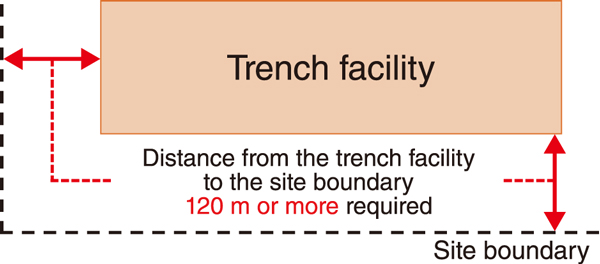
Fig.1 Schematic of skyshine γ-rays

Fig.2 Distance from the trench facility to the site boundary

Fig.3 Skyshine dose from a trench facility
The Japan Atomic Energy Agency (JAEA) has been establishing a disposal project of low-level radioactive waste generated from research, industrial, and medical facilities. It is necessary to evaluate the effective doses of direct and skyshine γ-rays from disposal facilities and reduce the doses below the target dose level (50 μSv/y) at the site boundary for safety assessment during operation. Fig.1 shows an image of the skyshine γ-rays.
The JAEA has established a conceptual design of disposal facilities under general environmental conditions for its disposal facilities. It was shown the distance from the disposal facilities (i.e., a trench facility) to the site boundary should be more than 120 m to satisfy the target dose (Fig.2). However, the design of trench facility was changed because of the increasing amount of waste that is subject to trench disposal. For example, for the stacking of waste, the conceptual design used three stacks, but after the design change, four stacks were used. The waste will be placed closer to the ground surface, and hence, an increase in the skyshine dose is expected. Therefore, we recalculated the skyshine dose from the trench facility and evaluated whether the criteria were met even after the design change.
Fig.3 shows the evaluation results for a trench facility where the skyshine dose is the highest. From Fig.3, even after the design change (━ in Fig.3), the dose criteria were satisfied at an evaluation distance of 120 m. However, since there was no more margin for this distance compared to the conceptual design (━ in Fig.3), the soil cover was thickened by 5 cm in the top layer (━ in Fig.3), and the skyshine dose was evaluated. The results confirmed that the skyshine dose at an evaluation distance of 120 m after changing the covering soil thickness (━ in Fig.3) decreased to two-thirds of that before changing the covering soil thickness (━ in Fig.3). By increasing the thickness of the top layer of the soil cover, we could secure a margin for the dose criteria.
These results indicate that when considering the facility layout and facility design at the location, the evaluation results for the distance to the site boundary (120 m or more) and tolerance for the criteria dose (50 μSv/y) of the skyshine dose should be examined. Design studies such as increasing the thickness of the soil cover on the top layer are regarded efficient. In addition, in facility layout and facility design, it is necessary to take into account the superimposition of the skyshine dose at the location.
We will continue to study the design in the future.
(Mizuki Nakamura)
<Previous: 10 Steadily Promote Backend Measures with the Highest Priority on Safety | Next: 10-2>